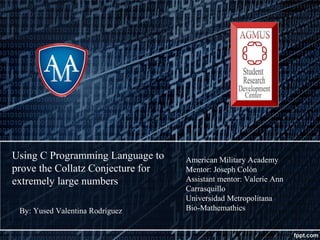Collatz Conjecture Research
•Als PPT, PDF herunterladen•
1 gefällt mir•534 views
Melden
Teilen
Melden
Teilen

Empfohlen
Empfohlen
Weitere ähnliche Inhalte
Was ist angesagt?
Was ist angesagt? (20)
Number Theory - Lesson 1 - Introduction to Number Theory

Number Theory - Lesson 1 - Introduction to Number Theory
Ähnlich wie Collatz Conjecture Research
Ähnlich wie Collatz Conjecture Research (20)
Probability and random processes project based learning template.pdf

Probability and random processes project based learning template.pdf
Paper Analysis Essay The 5-page Paper You Submit Must At L.docx

Paper Analysis Essay The 5-page Paper You Submit Must At L.docx
Cupdf.com introduction to-data-structures-and-algorithm

Cupdf.com introduction to-data-structures-and-algorithm
CMIS 102 Hands-On Lab Week 4OverviewThis hands-on lab all.docx

CMIS 102 Hands-On Lab Week 4OverviewThis hands-on lab all.docx
Paper Analysis Essay The 5-page Paper You Submit Must At L.docx

Paper Analysis Essay The 5-page Paper You Submit Must At L.docx
Brian Klumpe Unification of Producer Consumer Key Pairs

Brian Klumpe Unification of Producer Consumer Key Pairs
Collatz Conjecture Research
- 1. Using C Programming Language to prove the Collatz Conjecture for extremely large numbers By: Yused Valentina Rodríguez American Military Academy Mentor: Joseph Colón Assistant mentor: Valerie Ann Carrasquillo Universidad Metropolitana Bio-Mathemathics
- 2. Outline Abstract Slide 3 Introduction Slide 4 Study Area Slide 5 Procedure Slide 6 Results Slides 7 and 8 Proposition Slides 9 and 10 Conclusion Slide 11 Future Works Slide 12 References Slide 13 Acknowledgements Slide 14
- 3. Abstract The Collatz Conjecture, also known as the 3n+1 theory, is an unproven theory proposed by Lothar Collatz. It states that by using two simple functions (3n+1 for odd numbers and n/2 for even numbers), the outcome will ultimately be 1. This project involves using a different method to demonstrate the validity of said Conjecture. The goal of this investigation is to use C Programming Language, a general-purpose programming language, and a specific pseudo code made for this experiment in particular, to demonstrate the Collatz Conjecture with extremely large numbers. The chosen numbers will be tested on a high- functioning computer equipped with precise programming to see if they are, or they’re not, solutions to the Conjecture.
- 4. Introduction
- 5. Study Area
- 6. Procedure 1. Understand C Programming Language. 2. Create a working pseudocode for the Collatz Conjecture. 3. Turn the pseudocode into a source code. 4. Test code. 5. Record findings.
- 7. Results
- 8. Results Iterations for 112 Iterations for 75
- 9. Proposition For the code to properly run with the overly large numbers , a mechanism that divides the number into equal, or similar, parts will be developed and placed to work alongside the code. This mechanism is also known as “parallel computing”, which means that the different parts of the number will be worked on simultaneously as if they were single numbers. After the process is done to the segments of the number, each segment will be put side by side to create the total outcome of the original large number.
- 11. Future Works In the future, I hope to pursue further study in Bio-Mathematics and Programming, and run the code developed in this investigation with extremely large numbers on a super computer.
- 12. Conclusions After analyzing the Collatz Conjecture, a code was made that could run a number and apply the functions to determine whether or not that number stayed true to the Conjecture. But due to the immensity of the numbers, a mechanism to divide them into parts and work with those segments individually was created. Said mechanism will be applied with the code to the Collatz Conjecture in a further investigation.
- 13. References • C Tutorial. (n.d.). - Learn C. Retrieved March 15, 2014, from http://www.cprogramming.com/tutorial/c-tutorial.html • C Tutorial – for loop, while loop, break and continue. (n.d.). CodingUnit Programming Tutorials. Retrieved March 15, 2014, from http://www.codingunit.com/c-tutorial-for-loop- while-loop-break-and-continue • C Tutorial – printf, Format Specifiers, Format Conversions and Formatted Output. (n.d.). CodingUnit Programming Tutorials. Retrieved March 15, 2014, from http://www.codingunit.com/printf-format-specifiers-format- conversions-and-formatted-output
- 14. Acknowledgements • Dr. Juan F. Arratia – Executive Director of Student Research Development Center • Wanda Rodriguez – IM Coordinator • Joseph Colón Villers – Mentor • Valerie Ann Carrasquillo – Assistant Mentor • AGMUS Institute of Mathematics
- 15. Thank you